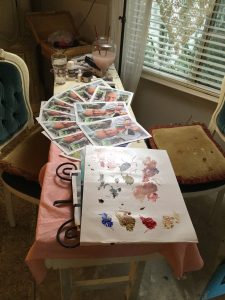In Part 1 we looked at the general considerations when selecting eyeglass frames, and my process of painting or “trying on” several shapes in the process of finding harmonious eyeglass frames for Greg.

Those key general considerations are:
- Who you are in terms of your archetypal season.
- Clarifying your dominant intentions and style identity.
- The overall appearance design of your face.
Here in Part 2, I discuss several technical issues relating purely to design considerations I think about when choosing the right frames, and in Part 3 I’ll finish the technical issues and then focus on the style identity and vocabulary of Greg’s eyeglass frames.
Academically, there are technical things to think about just in terms of the variations found in eye frame design. Below are the design features of eyeglass frames you’ll want to consider in helping you decide the most harmonious shape for your face design. This list does not consider your Seasonal archetype or your Style identity. But, as you can see in the image below, it takes a lot of trial and error to find the right shapes. At this point in the process, I haven’t yet found the best eye frame shape.
These are some of the things to think about when you go to the frame shop or peruse online sites:
- The width of the bridge of the frame should relate to the shape at the end of your nose as you look in the mirror straight on.
- The visual weight of your frames should relate to your overall inherent “visual weight”. If, for instance, you appear to be lightweight visually, heavy or medium weight frames will overwhelm and dominate your face. I educate my clients on what their overall visual weight is, so they can have the tools necessary to understand themselves visually and shop wisely. For now, ask yourself how heavy or dominant your eyebrows appear, how strong or delicate your features appear, and how dark or light your hair is – determining these three factors will help you think about your inherent “visual weight”. The darker, thicker and stronger your face appears, the “heavier” your visual weight is. The opposite qualities render a “light” visual weight impression. “Medium “ is usually a combination and can be tricky to identify without an objective trained eye.
- The shape of the frame bridge should repeat the silhouette at the bottom of your nose. Observe this shape by looking straight on in the mirror. Is it a “C” shape, an arrow (angular), rounded like a ball, an oval, or a straight line? Whichever it is, repeat this theme.
- A high or low bridge? This depends on the length and vertical line of your nose. Generally, if you have a longer nose the low bridge might balance you out. If you’re wanting to exaggerate the vertical movement of your face then try a high bridge. Short noses often look best with the elongation that a high bridge renders.
In Part 3, I will show you the best eyeglass frame shape for who Greg is and what he wants.
May the colors be with you,
Pati
Master Color Designer and Style Guide


Comments 1
Hello!
Is there any possibility to ask for a consulting regarding eye glass shapes?